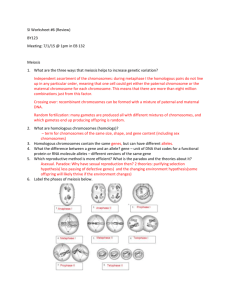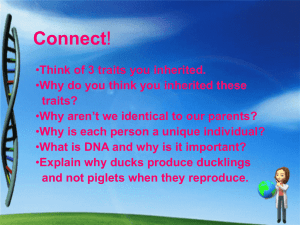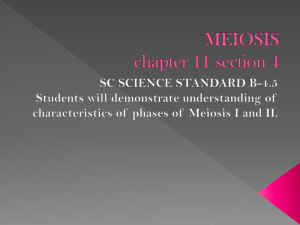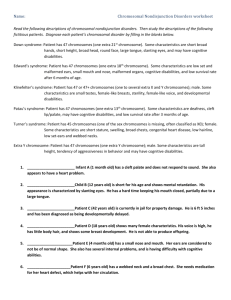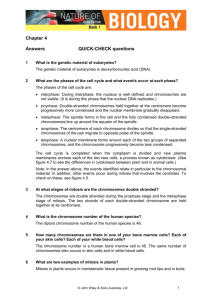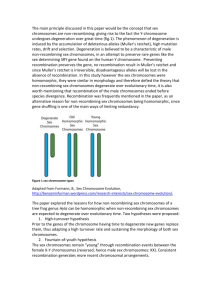Meiosis : Post Test - Gulf Coast State College
advertisement
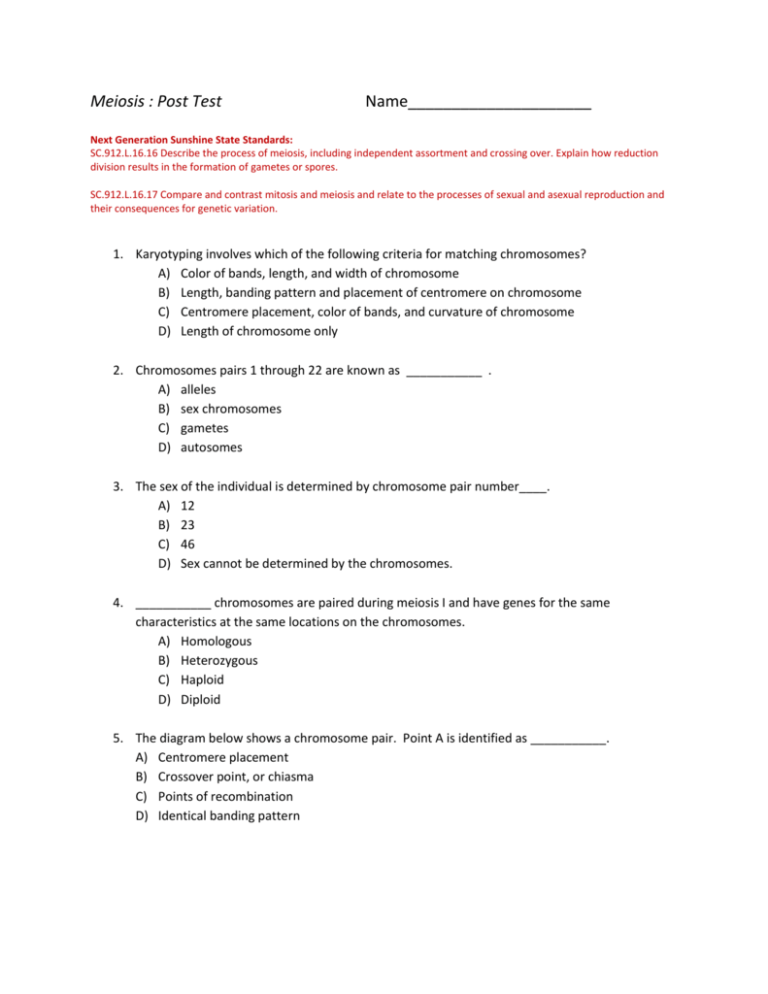
Meiosis : Post Test Name_____________________ Next Generation Sunshine State Standards: SC.912.L.16.16 Describe the process of meiosis, including independent assortment and crossing over. Explain how reduction division results in the formation of gametes or spores. SC.912.L.16.17 Compare and contrast mitosis and meiosis and relate to the processes of sexual and asexual reproduction and their consequences for genetic variation. 1. Karyotyping involves which of the following criteria for matching chromosomes? A) Color of bands, length, and width of chromosome B) Length, banding pattern and placement of centromere on chromosome C) Centromere placement, color of bands, and curvature of chromosome D) Length of chromosome only 2. Chromosomes pairs 1 through 22 are known as ___________ . A) alleles B) sex chromosomes C) gametes D) autosomes 3. The sex of the individual is determined by chromosome pair number____. A) 12 B) 23 C) 46 D) Sex cannot be determined by the chromosomes. 4. ___________ chromosomes are paired during meiosis I and have genes for the same characteristics at the same locations on the chromosomes. A) Homologous B) Heterozygous C) Haploid D) Diploid 5. The diagram below shows a chromosome pair. Point A is identified as ___________. A) Centromere placement B) Crossover point, or chiasma C) Points of recombination D) Identical banding pattern B A 6. “B” refers to _____________. A) Centromere placement B) Crossover point, or chiasma C) Points of recombination D) Identical banding pattern 7. Using the karyotype below, what can you determine about this individual? A) B) C) D) The individual will have the characteristics of Down’s syndrome. The individual will have the characteristics of Klinefelter’s syndrome. The individual experienced genetic recombination. No special condition occurs. This is within the normal range of chromosomal order. 8. Using the diagram above, determine the sex of the individual. A) This individual is male. B) This individual is female. C) Chromosome 23 is not homologous, so the individual could not survive. D) The sex cannot be determined by simply viewing the karyotype. 9. During Mitosis I, homologous chromosomes from each parent cross over at points and trade places, leaving a portion of one parent’s chromosome attached to the other’s chromosome. This is referred to as ___________________. A) Independent assortment B) Genetic recombination C) Karyotyping D) Cytokinesis 10. Nondisjunction, the abnormal separation of chromosomes during meiosis, may result in _______________ among the daughter cells. A) an abnormal amount of somatic chromosomes only B) an abnormal amount of sex chromosomes only C) an abnormal amount of either somatic or sex chromosomes D) an abnormal recombination in the genes. 11. A condition characterized by an individual having six fingers is ___________________. A) polydactyly B) polyploidy C) polygenic D) trisomy 21 12. Chromosomes appear to have dark bands. The bands are called “G bands” because ___________________________________. A) they are composed mostly of a concentration of the amino acid guanine B) they each represent a single gene C) they are stained with a substance called Giemsa dye. D) this is short for “genetic band” 13. Which of the following is NOT true? A) Males (human) produce two gametes, an X and a Y. B) Homologous autosomes look alike. C) Females have a 23rd pair of chromosomes depicted by XX. D) The 23rd pair of chromosomes are homologous in both males and females.



